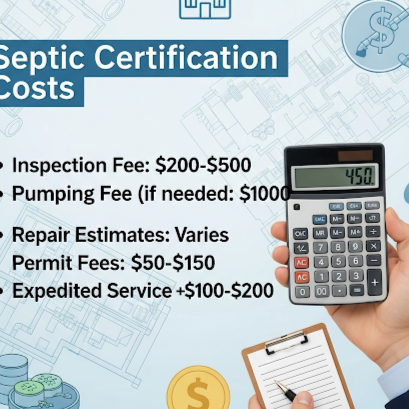When selling a home with a septic system, one of the most critical steps is obtaining a septic certification. For many homeowners, the question is simple yet pressing: What is the septic certification cost, and how does it affect the home-selling process?
A septic certification not only provides peace of mind to buyers but also ensures compliance with state and local regulations. Without it, you could face delays in closing or even lose a potential sale. In this comprehensive guide, we’ll break down septic certification cost, why it matters, what factors influence the price, and how homeowners can prepare for the process.
What Is a Septic Certification?
A septic certification is a professional inspection and verification that your home’s septic system is functioning properly. It is typically required when selling a property that relies on a private septic system instead of city sewer lines.
The inspection evaluates:
-
The tank’s condition and structural integrity
-
Whether the system processes wastewater efficiently
-
Any leaks, cracks, or blockages
-
Compliance with local health and environmental codes
Once the inspection is complete, a certified report is issued. This report reassures buyers that the system is safe, effective, and won’t require immediate costly repairs.
Why Is Septic Certification Important Before Selling a House?
Selling a house is already complex, and issues with the septic system can derail a deal quickly. Buyers often hesitate to purchase a property without clear evidence that the septic system is in good condition.
A septic certification is important because it:
-
Builds buyer confidence
-
Prevents surprises during closing
-
Ensures compliance with local regulations
-
Protects both buyer and seller from future liability
For example, a homeowner in North Carolina was ready to sell their three-bedroom property. When the buyer requested a septic certification, the inspection revealed a cracked distribution box. The homeowner spent $1,200 on repairs but avoided losing the sale because the certification gave the buyer confidence to proceed.
How Much Does a Septic Certification Cost?
On average, septic certification costs range between $300 and $1,000, depending on several factors. Basic inspections may fall on the lower end, while more detailed evaluations with pumping or camera inspections can push costs higher.
Typical cost ranges include:
-
Basic Certification: $300 – $500
-
Certification with Pumping Included: $500 – $800
-
Advanced Inspection with Camera/Repairs: $800 – $1,200+
It’s important to note that these prices vary by state, property size, and accessibility of the septic system.
Factors That Influence Septic Certification Cost
Several factors contribute to septic certification cost, and understanding them can help you budget accurately.
Location and Local Regulations
Different states and counties have varying requirements for septic certification. For instance, in California, septic inspections may require additional water testing, while in rural North Carolina the process may be more straightforward.
Size of the Septic System
Larger homes with bigger tanks often require more time to inspect, leading to higher costs. A four-bedroom home with a 1,500-gallon tank will likely cost more than a two-bedroom home with a smaller system.
Accessibility of the Septic Tank
If the tank is buried under landscaping, driveways, or structures, additional labor is needed to access it. This can increase the overall cost of the certification.
Pumping Requirements
Some septic certifications require the tank to be pumped before inspection. Pumping alone can cost between $200 and $500, which may or may not be included in the certification fee.
Repair or Maintenance Needs
If issues are found, such as clogged pipes, cracked lids, or failing leach fields, repairs will add to the total cost. While these aren’t part of the certification fee itself, they’re necessary for passing the inspection.
Who Pays for the Septic Certification?
In most real estate transactions, the seller is responsible for obtaining septic certification. This ensures the buyer has confidence in the property’s condition before moving forward. However, in some negotiations, the buyer may agree to share or cover costs depending on the local market and demand for the property.
For example, in a seller’s market where homes are in high demand, buyers may agree to cover septic certification costs to secure the property quickly.
What to Expect During the Septic Certification Process
Understanding the inspection process can reduce stress and help homeowners prepare.
Step 1: Scheduling the Inspection
Hire a licensed septic professional who is certified in your state. They will schedule a convenient time to inspect the system.
Step 2: Initial Evaluation
The inspector will locate the septic tank, open access points, and check for structural integrity.
Step 3: System Testing
Water is run through the system to check for drainage, backups, and efficiency. In some cases, a camera is used to inspect underground pipes.
Step 4: Pumping (If Required)
If pumping is needed, the septic company will empty the tank for a more thorough inspection.
Step 5: Certification Report
After inspection, a detailed report is issued, confirming whether the system meets local standards. If repairs are required, the report will note them before certification can be granted.
Real-Life Example: Septic Certification Before Closing
Consider the case of a homeowner in Pennsylvania who listed their rural property for $280,000. The buyer’s lender required septic certification before approving the loan. During the inspection, the system was found to be functioning but needed pumping and a new tank lid. The total cost was $750, which the seller paid. This upfront investment prevented the deal from falling apart and allowed closing to proceed smoothly.
How to Reduce Septic Certification Costs
redheadhomeproperties can take proactive steps to reduce expenses during the certification process.
-
Maintain Your Septic System Regularly: Pump every 3–5 years to avoid buildup.
-
Keep Records: Having past service records makes inspections quicker.
-
Locate the Tank in Advance: Save time by marking the access point for inspectors.
-
Avoid Last-Minute Repairs: Address small issues early to avoid costly emergency repairs.
By maintaining your system and preparing in advance, you can avoid inflated costs when it’s time for certification.
Common Problems Found During Septic Certification
During certification, inspectors often uncover issues that can delay or increase costs. Common problems include:
-
Tree roots invading pipes
-
Cracked tank lids or walls
-
Clogged drain fields
-
Improper water flow
-
Tank overflow due to lack of pumping
If these issues are discovered, repairs must be completed before certification is approved.
Do You Need Septic Certification If Not Selling?
While septic certification is usually required for property sales, it can also be beneficial for homeowners who aren’t planning to sell. Certification provides:
-
Peace of mind about system health
-
Evidence for refinancing or insurance
-
Documentation for future buyers
Proactively obtaining certification can also help you plan maintenance before problems escalate.
FAQ: Septic Certification Cost
1. How much does septic certification usually cost?
Septic certification typically costs between $300 and $1,000, depending on system size, location, and whether pumping is required.
2. Who pays for septic certification in a home sale?
Generally, the seller is responsible for paying septic certification costs, though it can be negotiated during the sales process.
3. How long does a septic certification take?
Most inspections take 1–3 hours, depending on accessibility and system size.
4. Can I sell my home without septic certification?
In many states, septic certification is legally required before a property can transfer ownership. Even where it isn’t mandated, most buyers or lenders will request it.
5. What happens if my septic system fails certification?
If your system fails, necessary repairs must be completed before certification is issued. The cost depends on the extent of the damage, ranging from minor fixes to full system replacement.
6. Is septic certification the same as septic pumping?
No. Pumping is the process of emptying the tank, while certification is an official inspection and report. Sometimes pumping is required as part of the certification process.



